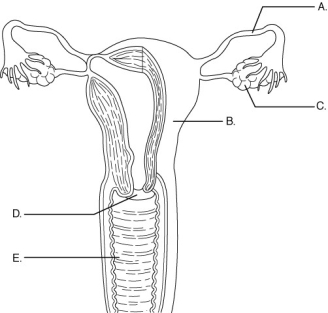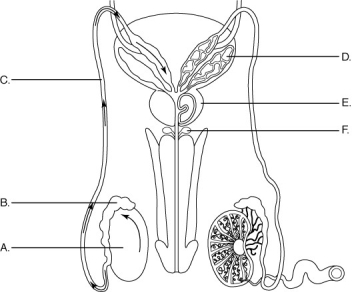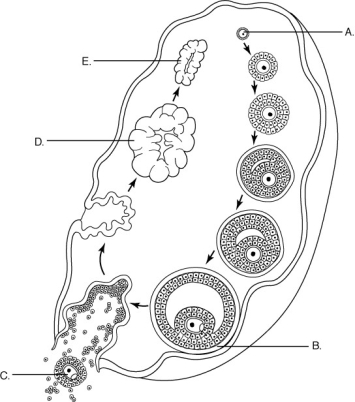Correct Answer

verified
Correct Answer
verified
Multiple Choice
The seminal vesicles produce which one of the following to serve as the energy source to fuel sperm motility?
A) fat
B) fructose
C) glutamine
D) prostaglandin
E) glucose
G) B) and D)
Correct Answer

verified
Correct Answer
verified
Short Answer
The regular pattern by which oocytes grow, mature, and are released from the ovary is known as the ________ cycle.
Correct Answer

verified
Correct Answer
verified
Short Answer
 Using the figure above, identify the organs of the female reproductive system.
-The uterus is indicated by letter ________.
Using the figure above, identify the organs of the female reproductive system.
-The uterus is indicated by letter ________.
Correct Answer

verified
Correct Answer
verified
Multiple Choice
During ejaculation, smooth muscle in the ejaculatory duct, seminal vesicles, epididymis, prostate, and bulbourethral glands are stimulated by
A) prostaglandins
B) ejaculatory-stimulation hormone
C) sympathetic nerves
D) parasympathetic nerves
E) LH and FSH
G) C) and E)
Correct Answer

verified
Correct Answer
verified
Multiple Choice
If fertilization does not occur following release of the egg by the ovary, then which one of the following degenerates approximately two weeks after ovulation?
A) primary oocyte
B) oviduct
C) endometrium layer
D) corpus luteum
E) choices A through D are correct
G) B) and D)
Correct Answer

verified
Correct Answer
verified
Multiple Choice
Which one of the following viruses is associated with cervical cancer?
A) Treponema pallidum
B) Human papilloma virus
C) Herpes simplex virus
D) Chlamydia trachomatis
E) Hepatitis B
G) A) and B)
Correct Answer

verified
Correct Answer
verified
Multiple Choice
The production and secretion of testosterone depends on the secretion of three other hormones; GnRH is secreted by the ________, and FSH and LH are secreted by the ________.
A) hypothalamus, anterior pituitary gland
B) testes, scrotum
C) posterior pituitary gland, anterior pituitary gland
D) seminal vesicle, prostate gland
E) posterior pituitary gland, hypothalamus
G) C) and E)
Correct Answer

verified
Correct Answer
verified
True/False
Since the chance of any one particular sperm fertilizing an egg is very low, large numbers of sperm are produced by the male reproductive system.
B) False
Correct Answer

verified
Correct Answer
verified
Short Answer
 Using the figure above, match each organ (A-F) to its description.
-structure that transports sperm to the ejaculatory duct; sperm are stored here until ejaculation
Using the figure above, match each organ (A-F) to its description.
-structure that transports sperm to the ejaculatory duct; sperm are stored here until ejaculation
Correct Answer

verified
Correct Answer
verified
True/False
The lining of the uterus is termed the myometrium.
B) False
Correct Answer

verified
Correct Answer
verified
Multiple Choice
During male ejaculation, the internal urethral sphincter closes tightly to
A) prevent urine from leaking into the urethra
B) isolate the ureters from the urinary bladder
C) block movement of mucus from the bulbourethral gland into the ejaculatory duct
D) keep sperm from moving into the ductus deferens
E) allow seminal vesicle to transfer sperm to the epididymis
G) A) and D)
Correct Answer

verified
Correct Answer
verified
Multiple Choice
Use the figure below to answer the following question.
 -Which one of the following structures degenerates if a fertilized egg does not embed in the uterus?
-Which one of the following structures degenerates if a fertilized egg does not embed in the uterus?
A) ovary
B) oviduct
C) zona pellucida
D) corpus luteum
E) secondary oocyte
G) B) and D)
Correct Answer

verified
Correct Answer
verified
True/False
Testosterone controls the rate of sperm production.
B) False
Correct Answer

verified
Correct Answer
verified
Short Answer
 Using the figure above, identify the organs of the female reproductive system.
-The oviduct is indicated by letter ________.
Using the figure above, identify the organs of the female reproductive system.
-The oviduct is indicated by letter ________.
Correct Answer

verified
Correct Answer
verified
Multiple Choice
Which one of the following sexually transmitted diseases is currently the most prevalent in the United States?
A) gonorrhea
B) syphilis
C) AIDS
D) genital warts
E) chlamydia
G) A) and D)
Correct Answer

verified
Correct Answer
verified
Multiple Choice
The human papilloma virus (HPV) causes
A) gonorrhea
B) vaginal yeast infections
C) genital herpes
D) syphilis
E) genital warts
G) A) and E)
Correct Answer

verified
Correct Answer
verified
Short Answer
The muscular layer of the uterus that provides the force necessary to expel the baby during birth is called the ________.
Correct Answer

verified
Correct Answer
verified
Multiple Choice
Not all sperm produced by the testes are functional. A sperm with a defective acrosome would
A) not be able to swim
B) produce multiple flagella
C) not survive the acid pH of a vagina
D) not be able to penetrate a egg
E) be able to swim, but would travel in circles, unable to navigate a female reproductive tract
G) A) and C)
Correct Answer

verified
Correct Answer
verified
Multiple Choice
As sperm are produced, they go through several stages. Which one of the following stages develops directly into mature motile sperm?
A) primary spermatocytes
B) spermatogonia
C) spermatids
D) secondary spermatocytes
E) Sertoli cells
G) B) and E)
Correct Answer

verified
Correct Answer
verified
Showing 61 - 80 of 89
Related Exams